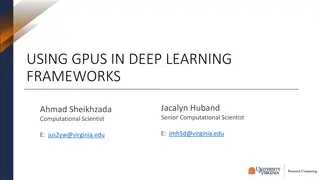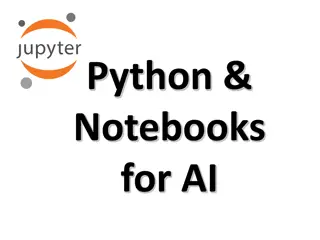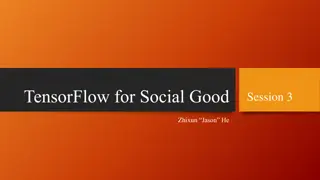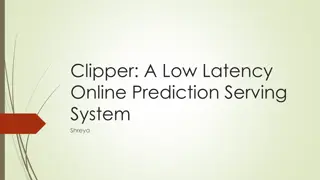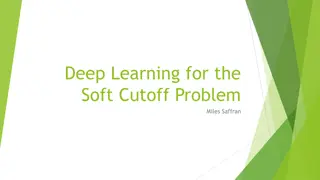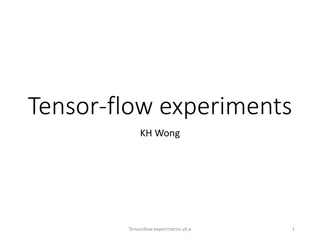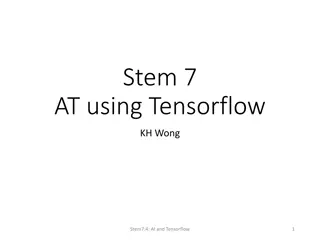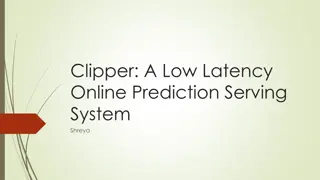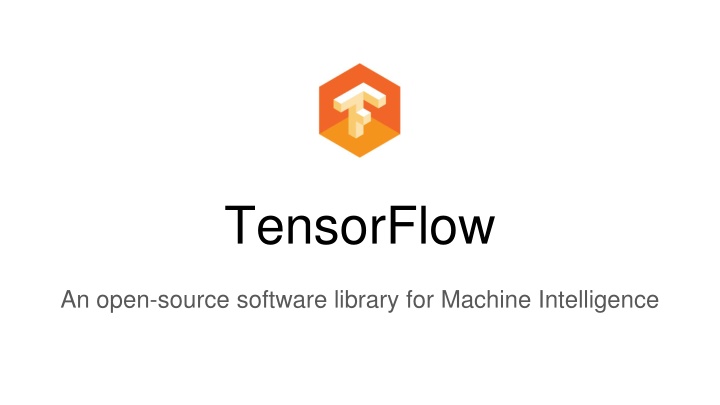
TensorFlow: Basics of Machine Intelligence
"Explore the fundamentals of TensorFlow, an open-source software library for machine intelligence, covering topics like tensors, operations, linear models, loss, optimizers, and training. Learn how TensorFlow facilitates numerical computation using data flow graphs and its applications across various domains."
Download Presentation

Please find below an Image/Link to download the presentation.
The content on the website is provided AS IS for your information and personal use only. It may not be sold, licensed, or shared on other websites without obtaining consent from the author. If you encounter any issues during the download, it is possible that the publisher has removed the file from their server.
You are allowed to download the files provided on this website for personal or commercial use, subject to the condition that they are used lawfully. All files are the property of their respective owners.
The content on the website is provided AS IS for your information and personal use only. It may not be sold, licensed, or shared on other websites without obtaining consent from the author.
E N D
Presentation Transcript
TensorFlow An open-source software library for Machine Intelligence
Contents 1.What is TensorFlow? 2.Basic concept 3.Basic operation 4.Linear model 5.Loss 6.Optimizer 7.Train
What is TensorFlow? TensorFlow was originally developed by researchers and engineers working on the Google Brain Team within Google's Machine Intelligence research organization for the purposes of conducting machine learning and deep neural networks research, but the system is general enough to be applicable in a wide variety of other domains as well.
What is TensorFlow? TensorFlow in the graph represent mathematical operations, while the graph edges represent the multidimensional data arrays (tensors) communicated between them. The flexible architecture allows you to deploy computation to one or more CPUs or GPUs in a desktop, server, or mobile device with a single API. is an open source software library for numerical computation using data flow graphs. Nodes
Basic concept Tensor A tensor consists of a set of primitive values shaped into an array of any number of dimensions. Here are some examples of tensors: [1. ,2., 3.] # a rank 1 tensor; this is a vector with shape [3] A tensor's rank is its number of dimensions. 3 # a rank 0 tensor; this is a scalar with shape [] [1. ,2., 3.] # a rank 1 tensor; this is a vector with shape [3] [[1., 2., 3.], [4., 5., 6.]] # a rank 2 tensor; a matrix with shape [2, 3] [[[1. 2. 3.]], [[7. 8. 9.]]] # a rank 3 tensor with shape [2, 1, 3]
Basic concept Flow Nodes in the graph represent mathematical operations, while the graph edges represent the multidimensional data arrays (tensors) communicated between them.
Basic operation Add const3=tf.constant(3.0,dtype=tf.float32) print(const3) const4=tf.constant(4.0,dtype=tf.float32) print(const4) const5=const3+const4 print(const5) print(sess.run(const5))
Basic operation Placeholder As it stands, this graph is not especially interesting because it always produces a constant result. A graph can be parameterized to accept external inputs, known as placeholders. A placeholder is a promise to provide a value later. a = tf.placeholder(tf.float32) b = tf.placeholder(tf.float32) adder_node = a + b # + provides a shortcut for tf.add(a, b) The preceding three lines are a bit like a function or a lambda in which we define two input parameters (a and b) and then an operation on them. We can evaluate this graph with multiple inputs by using the feed_dict parameter to specify Tensors that provide concrete values to these placeholders: print(sess.run(adder_node, {a: 3, b:4.5}))
Linear model Variables In machine learning we will typically want a model that can take arbitrary inputs, such as the one above. To make the model trainable, we need to be able to modify the graph to get new outputs with the same input. Variables allow us to add trainable parameters to a graph. They are constructed with a type and initial value: W = tf.Variable([.3], dtype=tf.float32) b = tf.Variable([-.3], dtype=tf.float32) x = tf.placeholder(tf.float32) linear_model = W * x + b
Loss We've created a model, but we don't know how good it is yet. To evaluate the model on training data, we need a y placeholder to provide the desired values, and we need to write a loss function. A loss function measures how far apart the current model is from the provided data. We'll use a standard loss model for linear regression, which sums the squares of the deltas between the current model and the provided data. linear_model - y creates a vector where each element is the corresponding example's error delta. We call tf.square to square that error. Then, we sum all the squared errors to create a single scalar that abstracts the error of all examples using tf.reduce_sum: y = tf.placeholder(tf.float32) squared_deltas = tf.square(linear_model - y) loss = tf.reduce_sum(squared_deltas) print(sess.run(loss, {x:[1,2,3,4], y:[0,-1,-2,-3]}))
Optimizer A complete discussion of machine learning is out of the scope of this tutorial. However, TensorFlow provides optimizersthat slowly change each variable in order to minimize the loss function. The simplest optimizer is gradient descent. It modifies each variable according to the magnitude of the derivative of loss with respect to that variable. In general, computing symbolic derivatives manually is tedious and error-prone. Consequently, TensorFlow can automatically produce derivatives given only a description of the model using the function tf.gradients. For simplicity, optimizers typically do this for you. For example, optimizer = tf.train.GradientDescentOptimizer(0.01)
Train train = optimizer.minimize(loss) sess.run(init) # reset values to incorrect defaults. for i in range(1000): sess.run(train, {x:[1,2,3,4], y:[0,-1,-2,-3]}) print(sess.run([W, b]))
Train linear regression in TensorFlow-Examples
references https://www.bbsmax.com/A/VGzlM3aVJb/ https://www.tensorflow.org/get_started/get_started#importing_tensorflow https://en.wikipedia.org/wiki/Gradient_descent https://github.com/aymericdamien/TensorFlow-Examples https://www.tensorflow.org/

